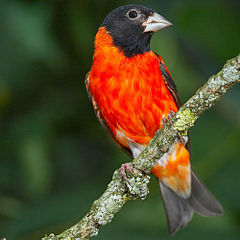- Red Siskin
-
Red Siskin 
Conservation status Scientific classification Kingdom: Animalia Phylum: Chordata Class: Aves Order: Passeriformes Family: Fringillidae Genus: Carduelis Species: C. cucullata Binomial name Carduelis cucullata
Swainson, 1820The Red Siskin, Carduelis cucullata, is a small passerine bird. This finch is a resident breeding bird in tropical South America in northern Colombia and northern Venezuela (where it's called "cardenalito"). The introduced population on Trinidad is believed to be extinct, with no sightings since 1960.
Some hope has been given to this highly endangered species by the discovery in 2003 of a population of several thousand birds in southern Guyana, 1000 km from any previously known colony. Otherwise the world population is believed to be between 600-6000 pairs.
The Red Siskin is found in open country, forest edges and grassland with trees or shrubs. The female is believed to lay 3 greenish white eggs in a grassy cup nest in a tree. It was common in the early twentieth century, occurring throughout the foothills of northern Venezuela but has now become extremely rare in a fragmented range.
The Red Siskin is about 10 cm long. The male is mainly deep red, with black on the head, throat, flight feathers and tail tip, and a whitish lower belly and undertail. The female is grey on the head, breast, and uppperparts, apart from a red rump and uppertail. The breast is grey with reddish flanks, and the rest of the underparts, the wings and tail resemble the corresponding areas of the male. Immature females are paler than the adults, and immature males are brown rather than red.
The call is a high-pitched chitter and sharp chi-tit like Indian Silverbill, and the male’s song is a musical goldfinch-like melody with twitters and trills.
Red Siskins eat seeds, and are highly gregarious. When they were more numerous they formed semi-nomadic flocks.
The downfall of this siskin has been massive illegal trapping for the cage bird trade. This is an attractive finch with a pleasant song, and its unique coloration for a small finch (most are predominantly yellow) has led to it being used for interbreeding with domesticated Canaries to produce varieties with red in the plumage.
Phylogeny
It has been obtained by Antonio Arnaiz-Villena et al.[1][2]
References
- ^ Arnaiz-Villena, Antonio; Alvarez-Tejado M., Ruiz-del-Valle V., García-de-la-Torre C., Varela P, Recio M. J., Ferre S., Martinez-Laso J. (1998). "Phylogeny and rapid Northern and Southern Hemisphere speciation of goldfinches during the Miocene and Pliocene Epochs". Cell.Mol.Life.Sci. 54(9): 1031–41. http://www.springerlink.com/content/r1ukblmke5d3uy1v/fulltext.pdf.
- ^ Zamora, J; Moscoso J, Ruiz-del-Valle V, Ernesto L, Serrano-Vela JI, Ira-Cachafeiro J, Arnaiz-Villena A (2006). "Conjoint mitochondrial phylogenetic trees for canaries Serinus spp. and goldfinches Carduelis spp. show several specific polytomies". Ardeola 53: 1–17. http://www.ardeola.org/files/1260.pdf.
- BirdLife International (2004). Carduelis cucullata. 2006. IUCN Red List of Threatened Species. IUCN 2006. www.iucnredlist.org. Retrieved on 11 May 2006. Database entry includes a range map and justification for why this species is endangered. RangeMap:
- Birds of Venezuela by Hilty, ISBN 0-7136-6418-5
- ffrench, Richard (1991). A Guide to the Birds of Trinidad and Tobago (2nd edition ed.). Comstock Publishing. ISBN 0-8014-9792-2.
- Finches and Sparrows by Clement, Harris and Davis, ISBN 0-7136-8017-2
External links
Categories:- IUCN Red List endangered species
- Carduelis
- Birds of Colombia
- Birds of Guyana
- Birds of Venezuela
- Birds of Trinidad and Tobago
- Birds of Puerto Rico
Wikimedia Foundation. 2010.

